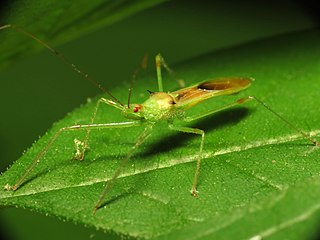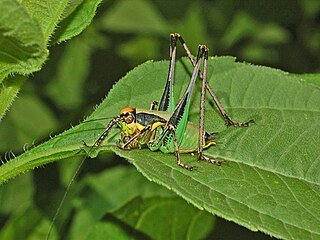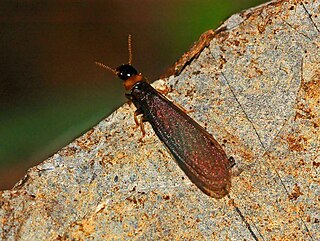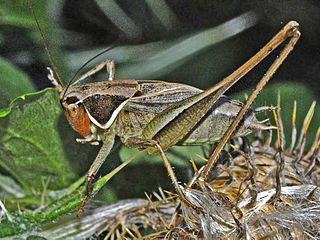
Saitis barbipes is a common jumping spider found in the Mediterranean region.

Mitopus morio is a species of harvestman arachnid belonging to the family Phalangiidae.
Thrandina is a genus of jumping spiders, with three species found in Ecuador. It is unique among New World salticids in having strikingly large posterior median eyes.

Zelus luridus, also known as the pale green assassin bug, is a species of assassin bug native to North America. It is the most common Zelus species in the eastern United States. The size ranges from 12.5 to 18 millimetres long. On average, adult females are 16 millimetres (0.63 in) long, while males are 14 millimetres (0.55 in) long. Though the base color is pale green, markings on the back can range from dark brown or red to bright yellow. Nymphs are generally more solid green, wingless, and with narrower bodies than adults. The most reliable feature to distinguish this species from others is the pair of spines on the rear corners of the pronotum. These spines are long on the lighter colored individuals and shorter on ones that are darker. It can also be distinguished by dark bands on the distal ends of the femurs, but these can often be too light to be easily seen. The egg masses, which are laid from late June to August, are conical in shape with a flat top. They are laid on leaves in groups of twenty to fifty and held together with a sticky, brownish material. Their bite is extremely painful.

Nesagapostemon is an extinct monotypic genus of sweat bee in the Halictidae subfamily Halictinae. At present, it contains the single species Nesagapostemon moronei.

Gryllomorpha dalmatina, common name wingless house-cricket, is a species of cricket belonging to the family Gryllidae subfamily Gryllomorphinae.

Metaplastes pulchripennis, common name Italian ornate bush-cricket, is a species of 'katydids crickets' belonging to the family Tettigoniidae subfamily Phaneropterinae.

Tylopsis lilifolia, the lily bush-cricket, is a species of Orthopterans in the subfamily Phaneropterinae. It is found in Europe and Asia.

Eupholidoptera chabrieri is a species of katydid belonging to the subfamily Tettigoniinae.

Yersinella raymondii, common name Raymond's bush-cricket, is a species of "katydids crickets" belonging to the family Tettigoniidae subfamily Tettigoniinae. The scientific name Yersinella comes from the name of the entomologist who has described the species in 1860.

Kalotermes flavicollis, the yellownecked dry-wood termite, is a species of dampwood termites belonging to the family Kalotermitidae, one of the most primitive families of termites.

Pholidoptera is a genus of bush-crickets belonging to the subfamily Tettigoniinae and the type genus of the tribe Pholidopterini.

Harpocera thoracica is a species of bugs from Miridae family.

The Panay shrew is a species of shrew from the Philippines.

Paedophryne swiftorum is a species of frog from Papua New Guinea discovered in 2008 and formally described in January 2012. It lives among leaf litter on the tropical rainforest floor and was named after the Swift family who had provided funds for establishing the Kamiali Biological Station where the new species was found.
Fijocrypta is a monotypic genus of South Pacific brushed trapdoor spiders containing the single species, Fijocrypta vitilevu. Both genus and species were first described by Robert Raven in 1994, and they have only been found in Fiji. It was first found in rainforests in the eastern highlands of Viti Levu, the largest island in Fiji, from which the species name is derived. The genus name is derived from "Fiji" and the Latin word cryptus, meaning "hidden".

Orthonotus rufifrons is a species of plant bugs belonging to the family Miridae.

Sepiana sepium, common name sepia bush-cricket, is a species of bush crickets belonging to the tribe Platycleidini and genus group Platycleis. It is the only species within the monotypic genus Sepiana.

Plexippus petersi is a species of jumping spider native to Asia that has been introduced to Africa and Pacific islands. The male is between 6 and 10 mm in length, and the female is around 10 millimetres (0.39 in). This spider is commonly known as the tropical flycatcher or small zebra jumper.
Baeoentedon bouceki is a species of wasp, one of the first three members of the genus Baeoentedon to be discovered in China. It is less than a millimetre in length, with a head slightly wider than the middle portion of the body. Only one specimen has been studied, collected from Hainan in 1983. As that specimen is female, the appearance of males is unknown.

















